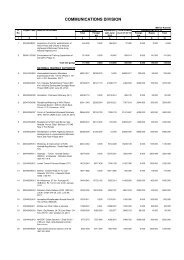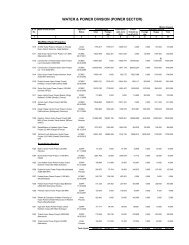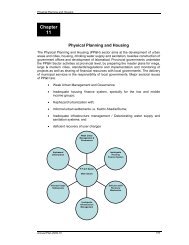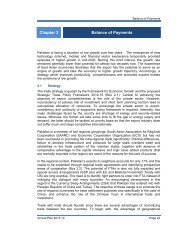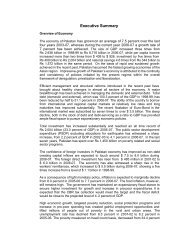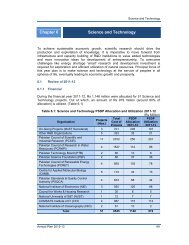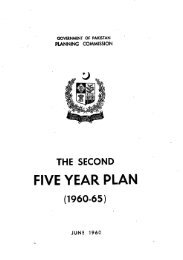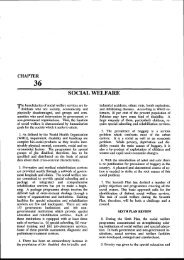Manual for Development Projects - Planning Commission
Manual for Development Projects - Planning Commission
Manual for Development Projects - Planning Commission
Create successful ePaper yourself
Turn your PDF publications into a flip-book with our unique Google optimized e-Paper software.
Chapter 5<br />
ii) Depreciation<br />
result of a discounted flow analysis is the allowance <strong>for</strong> the return to the entity capital<br />
(interest). If we compute net present worth, we are determining what would be left over<br />
after allowing <strong>for</strong> some specific rate of return to the entity's own capital, the interest.<br />
When we compute "IRR", this is return to the entity's own capital and, in a sense, is the<br />
interest which that capital earns. Thus, interest is not cost in deriving the cash flow <strong>for</strong><br />
financial/economic analysis.<br />
Project appraisal attempts to measure the profitability of all resources devoted to the<br />
project; it is not concerned with the way in which these resources are financed. Interest<br />
is the cost of time (waiting) and discount rate is also supposed to be a measure of the<br />
cost of waiting <strong>for</strong> future benefits. So interest is automatically allowed <strong>for</strong> in the<br />
discounting procedure. Since the principal of a loan is used to purchase building and<br />
equipment whose costs are already part of the cash flow, repayment of that principal<br />
would add a cost that had already been charged to the project. It may however be<br />
noted that interest on capital is to be shown in the overall cost of a project.<br />
Depreciation is an accounting concept necessary when accounts are to be prepared <strong>for</strong> one year<br />
at a time (not prepared as a projection over the life of the project) and must include an allowance<br />
<strong>for</strong> the capital use during each year. Actually a part of the project's revenue is set aside in an<br />
account labelled "depreciation" to ensure that some revenues are retained to replace capital when<br />
it wears out. Thus, it is neither a cost nor a cash outflow. In fact, to include it as a cost would be<br />
double-counting. So in determining the gross cost-stream <strong>for</strong> calculating out discounted measures<br />
of project worth we do not include depreciation as a cost or, expressing it in an other way, in<br />
computing the incremental net benefits, we do not deduct from the gross benefits any allowance<br />
<strong>for</strong> depreciation because the incremental net benefit-stream already allows <strong>for</strong> the return of capital<br />
(depreciation) over the life of the project. When we discuss cash flow, it is an undifferentiated<br />
combination of:<br />
(a) depreciation or amortization - return of capital<br />
(b)<br />
returns paid <strong>for</strong> the use of capital, such as, dividends, profits, and the like-returns of<br />
capital.<br />
We do not subtract depreciation as a cost. Yet the internal rate of<br />
Page 6 of 24<br />
return is a measure of the earning capacity of a project - that is, the return to capital - while net<br />
present worth determines whether a project can earn more than some stated amount of return to<br />
capital. The easiest way to go about illustrating what happens to depreciation is to compute the<br />
benefit-cost ratio, the net present worth, and the internal rate of return of a hypothetical example in<br />
which we analyse a project which does not exactly lose money, but, on the other hand, does not<br />
make money either. In other words, its internal rate of return is zero, its net present worth at zero<br />
discount rate is zero, and its benefit-cost ratio at zero rate of interest is just exactly one. Can we<br />
get our money back? Yes, we can. We spent say Rs 1,200,000 over the five years of the project<br />
and by the end of the fifth year suppose we have received just exactly Rs 1,200,000 back. So we<br />
do not lose any of our capital and we recovered all of our other costs. Did we earn anything on this<br />
project? No both the internal rate of return and the net present worth of this project were simply<br />
zero, and the benefit-cost ratio had to be computed at zero rate of interest to have them come out<br />
to 1. There<strong>for</strong>e, return of capital is realized (that is, depreciation is covered and fully accounted<br />
<strong>for</strong>) when the net present worth of the project at a zero discount rate is zero or greater, when the<br />
http://hd2/pc/popup/ch5_p.html<br />
9/23/2010




